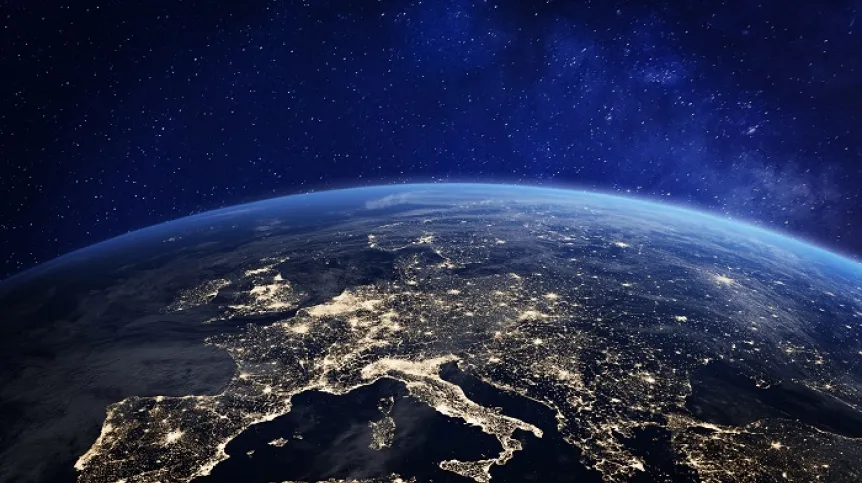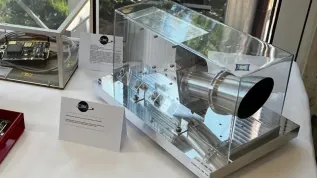
EagleEye is a pioneering device - the first Polish satellite with such a large telescope, says Dr. Tomasz Barciński from the Space Research Center at the Polish Academy of Sciences. The largest, most advanced Polish satellite has been launched into orbit.
Thanks to the satellite, Poland will gain independent access to high-resolution images of the Earth, with a variety of applications, says Dr. Barciński, head of the academy’s Satellite Mechatronics and Robotics Laboratory, who took part in the project.
'According to predictions, the images obtained thanks to EagleEye will have an exceptionally high resolution - reaching the order of 1 metre per pixel. These images will be taken in both visible and infrared light. This is a pioneering device - the first Polish satellite with such a large telescope. The applications can vary, from agriculture to observation of army movements', says Dr. Barciński.
He adds that it is important for Poland to have its own device of this type. 'Satellites of this type already exist in the world. They can be rented or purchased. The problem is that in this scenario, you are dependent on other entities. Additionally, there are certain restrictions - even after purchase, you cannot check how such a satellite is built, in order to be able to built another - your own', Barciński says.
That is why the construction of EagleEye required starting work practically from scratch. 'Information on the construction of satellites is limited. The army does not provide it almost at all, the industry shares it to a very limited extent - for example, there is information about the capabilities of a given device, but not how they have been achieved. These data are kept secret. At most, you can learn something from scientific publications. That is why we had to develop most of the technologies ourselves', Dr. Barciński says.
A consortium of three entities participated in the construction. 'The leader of the project is Creotech Instruments S.A., also responsible for the construction of the satellite platform. All other devices are mounted on it. Scanway S.A. built the Earth observation telescope. We, the Space Research Centre of the Polish Academy of Sciences, supplied the telescope's computer and developed algorithms to control the satellite’, says Barciński.
‘It’s [the computer’s] task is to process the image obtained in the telescope. The data must be read from the matrix and compressed, among other things. Artificial intelligence can initially classify the images and select those that are suitable for sending to Earth, for example, check whether there are clouds on them. This requires high computing power, and at the same time the computer must be small and consume little energy. We had to achieve a very high level of miniaturisation. Due to the high computing power, we are talking about a satellite supercomputer. This term refers to devices operating in orbit - it should not be confused with huge supercomputers operating on Earth’, Barciński continues.
'Of course, the microchips were ordered from foreign manufacturers, but the entire computer architecture was our work. The device was not invented specifically for EagleEye. We had been working on it for a long time. The way our institute operates is that we develop various technologies we know are needed during space missions. As part of the cooperation with Creotech, an opportunity arose to apply our technology in practice', says Dr. Barciński.
The Space Research Centre PAN also created complex algorithms to control the satellite. 'I personally developed the algorithms that control the satellite', he adds.
'This work is based mainly on mathematics and physics. These algorithms are designed, for example, to determine the position and orientation of the satellite relative to the Earth. Thanks to this, we know in which direction and when to point the satellite with the telescope to photograph the selected object. Moreover, once the telescope is set up, it has to track the photographed location for some time due to the movement of the satellite, similarly to tracking a speeding Formula 1 car with a telephoto lens. Without this tracking, the image would be blurry. Information on the orbital position is transmitted to the computer from GNSS (GPS) receivers. We can use this signal because the satellites responsible for the GPS system are located much higher. The orientation of the satellite is determined, by the star sensor, among other things. It is a camera with a powerful computer with a map of the sky. The sensor searches for a place on this map that currently appears in the camera and in this way finds the current orientation of the satellite', Barciński says, adding that control algorithms are one of the components of the satellite control system. 'To integrate them with the satellite, you need a special computer and software that allows you to run the algorithms. These very complicated parts are the work of the engineering group at Creotech Instruments S.A. .
'Full testing of these algorithms would only be possible if we already had a satellite operating in orbit, and additionally one equipped with a 'laboratory' for experimentation. We had to do it on Earth. However, this is not something very risky, this approach has been used in the space industry for years. We created a computer simulation - an advanced program covering the satellite itself, its systems and the surrounding environment. In this simulation, we could test the behaviour of the device.’
According to Dr. Barciński, more satellites of this size may be built in Poland.
'EagleEye is the first satellite based on Creotech's HyperSat platform. This platform can be compared to a car without passengers and a driver - different people can get in. Similarly, different systems can be mounted on a satellite platform: sensors, telescopes, scientific devices, etc. This means that other, advanced satellites could be created on this platform', Dr. Barciński continues.
Although this is just speculation for now, the technologies used in this project could theoretically be used in further space missions.
'In low Earth orbit, the satellite is protected from cosmic radiation by the magnetosphere. Outside it, radiation can easily damage various parts of the satellite. In Poland, also at the Space Research Center PAS, various technologies that can operate in deep space have been developed for the needs of various missions. In the future, Polish orbiters, e.g. lunar orbiters, based on this platform, may be created. At the moment, however, when it comes to Polish satellites, there are still many interesting places to explore in Earth orbit', he adds.
Dr. Barciński heads the Mechatronics and Satellite Robotics Laboratory at the Space Research Center PAS. He holds a Ph.D. in technical sciences in the field of automation and robotics. He was an assistant professor at the West Pomeranian University of Technology in Szczecin. He has been affiliated with the Space Research Centre of the Polish Academy of Sciences since 2011. He specialises in control theory and mechatronics and leads teams that take part in the most important space missions involving Poland, including the construction of the European X-ray space telescope ATHENA. He also works on the space garbage truck project - ESA ClearSpace ADRIOS. (PAP)
Marek Matacz
mat/ bar/ kap/
tr. RL













